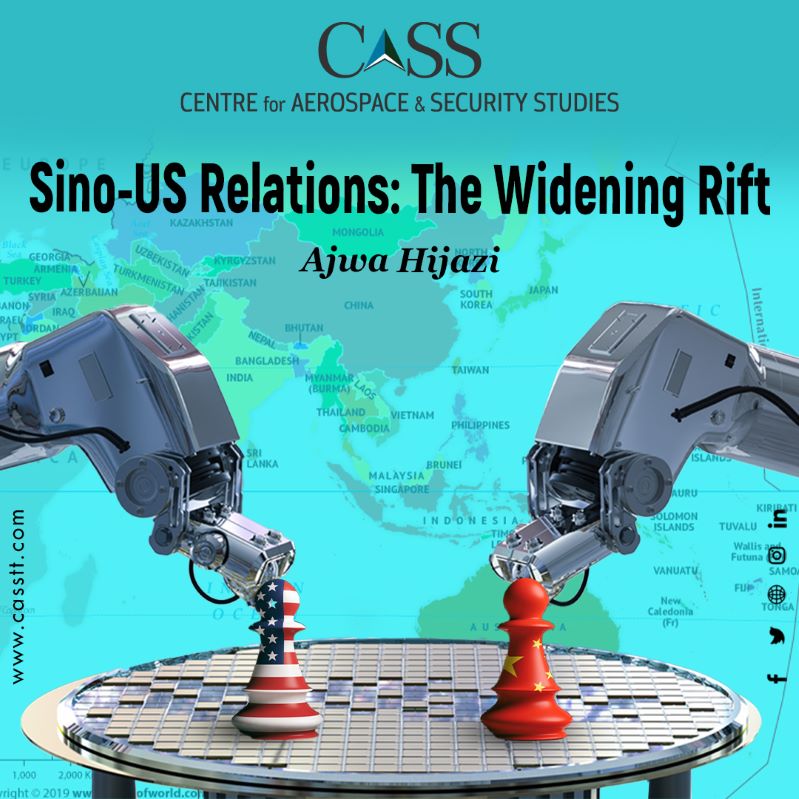The contentions between the United States (US) and China have been the defining feature of the international arena for years. The strain in bilateral relations has been stimulated by various causes ranging from trade to geostrategic competition. Recently, the Sino-US rivalry intensified after the US shot down an alleged Chinese ‘spy’ balloon flying over South Carolina, which China claimed was an airship for meteorological research. This incident upped the ante between the two countries, with the Secretary of State Blinken postponing his much-anticipated visit to the country.
However, the onset of this recent tension is preceded by an array of fronts where both countries have been at odds, especially over the past year, which notably includes the Taiwan issue amidst growing strategic competition in the Asia-Pacific; closer ties between China and Russia; and blocking of Chinese access to the chip technology by the US.
Since the past year, the Taiwan Strait has been a growing source of tension between the US and China. The high-level visit by former Speaker of the House of Representatives Nancy Pelosi to Taiwan in August 2022, subsequent US reiterations to defend the island, stopover by Pentagon’s top China official, Michael Chase and the ongoing five-day US Congressional visit have not gone down well with China. According to Beijing, US support of Taiwan’s independence violates the spirit of the ‘One-China Policy’. This discord is likely to intensify as, on February 2nd, the US secured a deal with the Philippines regarding access to military bases. Given the Philippines’ pivotal geographical location besides Taiwan and the South China Sea, China is likely to be even more perturbed by US presence in the region.
Apart from the ‘Indo-Pacific Strategy’ (February 2022) under the Biden Administration, the US’ pivot to the region is mentioned in various policy documents, including the recent National Security Strategy (October 2022). The US aims to contain China through enhanced alliances and multilateral economic engagements. The cooperative interaction among QUAD members and curation of the Indo-Pacific Economic Framework is testimony to that. However, experts have pointed out that the extent of China’s economic impact on the region, through its flagship Belt and Road Initiative (BRI) and Regional Comprehensive Economic Partnership (RCEP), is more profound than the US’ economic endeavours. To outcompete, the US needs to strengthen its economic posture by opening up its market and maintaining a flexible regime of low tariffs. Besides, re-joining the now-Comprehensive and Progressive Agreement for Trans-Pacific Trade (CPTTP) is another policy option. Nevertheless, the pursuit of both countries to enlarge their sphere of influence in the Asia-Pacific is likely to remain intact.
Against the backdrop of growing rivalry in the Asia-Pacific region, China’s neutrality in the Russia-Ukraine War is being considered a pro-Russian stance by US and its European allies. According to the Chinese Ambassador to France, Lu Shaye, Sino-Russia and Sino-Europe relations could go hand in hand. In the same vein, President Xi has set up a new diplomatic team, under Foreign Minister Qin Gang to reset ties the European Union (EU). Moreover, President Xi’s top foreign policy advisor, Wang Yi, has been on a visit to Europe since February 14th, with Moscow being his last stop. This visit is significant as it would reflect not only on China’s diplomatic prowess to balance its relationship with Russia and Europe, but also indicate how European countries withstand US pressure to maintain distance from Beijing.
The Sino-US tussle has not been limited to the economic and foreign policy front alone – a new war zone has emerged in this realm – the chip industry. In October 2022, the US imposed export controls to halt Chinese access to semiconductor chips made with American material. Labelling this move as ‘technology terrorism’, China filed a complaint with the World Trade Organization (WTO) in December, right after the latter’s ruling against US’ metal tariffs. It is yet to be seen how the US will maintain unity among its allies (Taiwan, Japan, and South Korea) as this battle between the two superpowers significantly impacts their global supply chains of the semiconductor industry.
At a time when the world is entangled in the chains of natural and human-driven crises, hostility between the two superpowers, with the prospect of more trust deficit, projects a future with an unstable global order. The resolve to maintain bilateral communication on the ‘balloon saga’ is encouraging, but it remains to be seen if it will be sustainable. Given the magnitude of the global impact of Sino-US hostility, the two states should work towards reducing the spectrum of tension through diplomatic engagements, instead of aggravating conflictual fault lines.
Ajwa Hijazi is a Research Assistant at the Centre for Aerospace & Security Studies (CASS), Islamabad, Pakistan. She can be reached at: [email protected].





